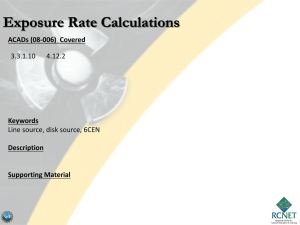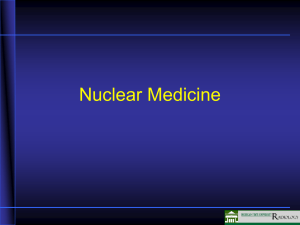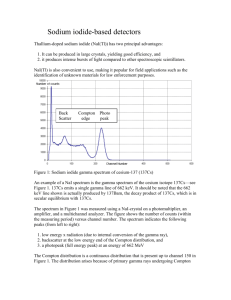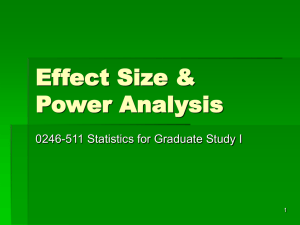In-Situ Nuclear Measurement for Decommissioning : Recent
advertisement
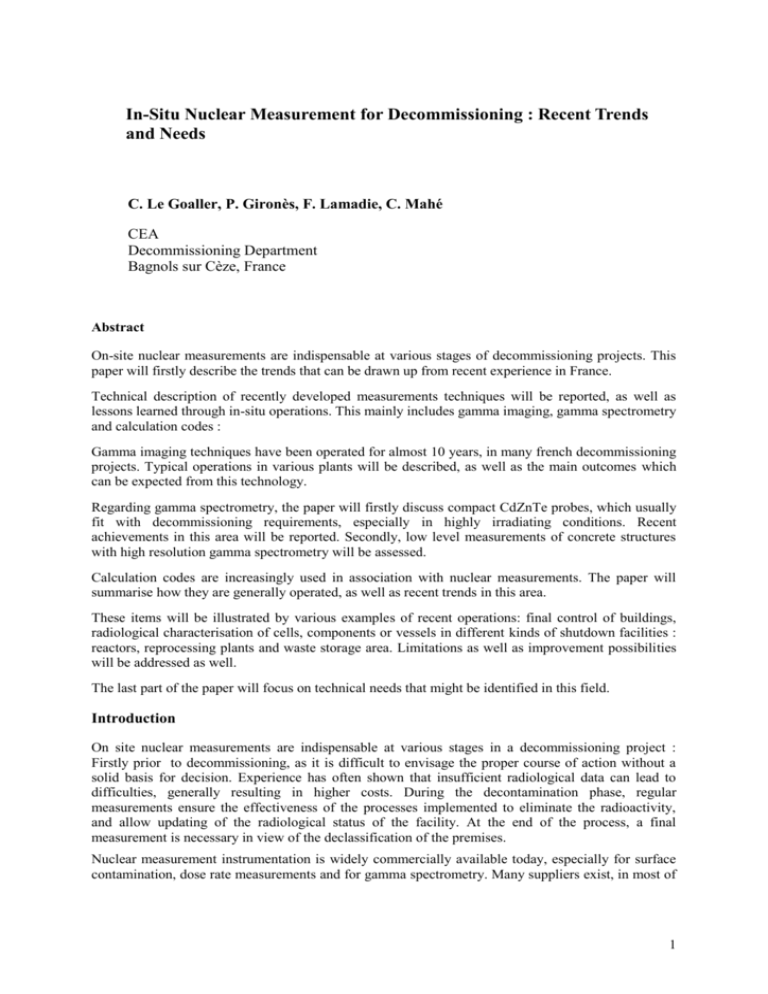
In-Situ Nuclear Measurement for Decommissioning : Recent Trends and Needs C. Le Goaller, P. Gironès, F. Lamadie, C. Mahé CEA Decommissioning Department Bagnols sur Cèze, France Abstract On-site nuclear measurements are indispensable at various stages of decommissioning projects. This paper will firstly describe the trends that can be drawn up from recent experience in France. Technical description of recently developed measurements techniques will be reported, as well as lessons learned through in-situ operations. This mainly includes gamma imaging, gamma spectrometry and calculation codes : Gamma imaging techniques have been operated for almost 10 years, in many french decommissioning projects. Typical operations in various plants will be described, as well as the main outcomes which can be expected from this technology. Regarding gamma spectrometry, the paper will firstly discuss compact CdZnTe probes, which usually fit with decommissioning requirements, especially in highly irradiating conditions. Recent achievements in this area will be reported. Secondly, low level measurements of concrete structures with high resolution gamma spectrometry will be assessed. Calculation codes are increasingly used in association with nuclear measurements. The paper will summarise how they are generally operated, as well as recent trends in this area. These items will be illustrated by various examples of recent operations: final control of buildings, radiological characterisation of cells, components or vessels in different kinds of shutdown facilities : reactors, reprocessing plants and waste storage area. Limitations as well as improvement possibilities will be addressed as well. The last part of the paper will focus on technical needs that might be identified in this field. Introduction On site nuclear measurements are indispensable at various stages in a decommissioning project : Firstly prior to decommissioning, as it is difficult to envisage the proper course of action without a solid basis for decision. Experience has often shown that insufficient radiological data can lead to difficulties, generally resulting in higher costs. During the decontamination phase, regular measurements ensure the effectiveness of the processes implemented to eliminate the radioactivity, and allow updating of the radiological status of the facility. At the end of the process, a final measurement is necessary in view of the declassification of the premises. Nuclear measurement instrumentation is widely commercially available today, especially for surface contamination, dose rate measurements and for gamma spectrometry. Many suppliers exist, in most of 1 C. Le Goaller et al. the "nuclear" countries. This instrumentation has been marketed for a long time, basically for radiation protection or waste management purposes. This paper describes some recent achievements regarding on-site measurements in decommissioning operations : gamma imaging, CdZnTe gamma spectrometry, low level high resolution gamma spectrometry and user- friendly calculation codes. The equipments and performances will be reported, as well as lessons learned through on-site operations. Although these new equipments of methods can definitely be of great help to decommissioning projects, new techniques should be investigated. This issue will be discussed in the last part of the paper. 1. Gamma imaging Gamma imaging is designed to quickly localize irradiating sources or hot spots. This technique is relatively new: the first operational prototypes were developed during the 1990s, mainly for decommissioning applications [1]. As the main requirement was to produce a compact unit, the CEA initially focused on pinhole gamma cameras that are capable of superimposing a gamma image on the corresponding visible-light image. An industrial version, so called Cartogam gamma camera, was available in 2000 [2,3]. The operating range extends from 0.1 µGy·h-1 to about 5 Gy·h-1 for the observation of a 137Cs point source. Modeling and experience have shown that the gamma camera can be operated in an ambient dose rate up to a few tens of Gy·h-1, providing that prolonged exposure to point sources producing a few Gy·h-1 is avoided. As the camera is protected by a Denal collimator and annular shield 2 cm thick, the upper limit is much higher for extended sources than for point sources. (a) Irradiation sources in a power reactor circuit Acquisition time : 60s Dose rate : 0.7 mGy.h-1 Spectrum : n.a. (b) Hot spots in a reprocessing cell Acquisition time : 20 s Dose rate : 50 mGy.h-1 Spectrum : mainly 137Cs, 125Sb (c) Contamination deposit in a glovebox Acquisition time : 300 s Dose rate : < 1µGy.h-1 Spectrum : Pu/Am isotopes (d) (e) (f) Removal of an activated Old waste monitoring Same scene as (e) from component from a reactor vessel Acquisition time : 30s another view point. acqq. Time : 60 s Dose rate : approx. 1 mGy.h-1 dose rate 1 mGy.h-1 Figure 1 : operation of gamma imaging in different kinds of nuclear plants. 2 C. Le Goaller et al. The acquisition time depends on both of the camera settings and the dose rate. It usually ranges between 10 s and a few minutes. Low level imaging (< 1 µGy.h-1) requires longer durations, up to a few tens of minutes. In addition to localizing activity concentrations, which remains their primary objective, gamma cameras can also be used to estimate the dose rate produced by a source within the field of view. The signal analyzed is the net integral of the region corresponding to the source, divided by the acquisition time. This requires, however, a known radiation energy and experimental calibration of the system. Moreover, as only unscattered radiation from the image is acquired, the dose rate may be underestimated in case of thick shields between the source and the camera. This interesting feature is fully mature regarding point sources. The related uncertainty remains below +/- 30%, which is acceptable. As regards extended sources, dose rate quantification is still on a validation stage. However, recent results turn out to be quite encouraging. For the last ten years, gamma imaging has been increasingly operated in most types of fuel cycle facilities (see fig.1), with different objectives : obtain a radiological inventory of cells or individual components before or during decommissioning, optimize radiological protection by localizing hot spots that significantly contribute to the ambient irradiation, improve the knowledge of the radiological state of waste. Laser CZT detector Dose rate probe Color camera Gamma camera (a) (b) Figure 2 : gamma camera + equipment (a) – CdZnTe compact gamma spectrometry detector (b) Although gamma cameras were not specifically designed for waste monitoring, experience showed that gamma images of waste could be useful. As an example, Figure 1e and 1f show two convergent images of the same drums. Obviously, the most irradiating source is located on the bottom of the drum which stands at the right side. The experience in this area is limited, but it is likely that compact gamma imaging devices can be of great interest in those areas where old radioactive waste need to be sorted without requesting bulky equipment. Experience has shown that gamma imaging was to be preferably operated in association with other compact measurement tools. Figure 2a shows a gamma camera prototype coupled with a visible color camera, a dose rate probe as well as a collimated gamma spectrometry probe (CdZnTe) [4]. A Laser pointer mounted on the collimator is aligned with the collimator centerline. This association results in a compact device, which can bring about a detailed radiological characterization : The location and extent of each hot spot (gamma imaging), the gamma spectrum of each of them (collimated gamma spectrometry), the "unscattered" dose rate produced by each hot spot (gamma imaging) as well as ambient dose rate. These data can be used as input data of radiation modeling tools, resulting in a 3D radiological model [8](see part 3). Although the usefulness of gamma imaging was proven, some drawbacks still need to be addressed : the price of equipment, which generally exceeds 150 k€. it requires experienced operators. gamma imaging can be affected by strong radiation sources outside of the field of view. 3 C. Le Goaller et al. 2. the sensitivity does not allow low level operations, such as release measurements or low level environmental monitoring. Gamma spectrometry 2.1. CdZnTe detectors A recent trend regarding gamma spectrometry is the use of compact CdZnTe detector, a semiconductor crystal capable of room-temperature operation. These detectors can be used with conventional gamma spectrometry electronics to obtain spectra in hard to access or congested areas. Since 1998, The CEA has extensively qualified these detectors in a variety of environments: reprocessing cells, reactors (mainly activation products [5]), and waste monitoring (241Am/137Cs ratio). Underwater operation were also successfully carried out [6]. Industrial detectors are now available with volumes ranging from 0.5 mm3 to 1500 cm3. The smallest detectors can be operated in high irradiation fields, up to 10 Gy.h-1 (137Cs). Conversely, the biggest crystal are suitable for low level measurements, around 1 µGy.h-1 (137Cs). Experience showed that these probes could meet many requirements related to decommissioning : they are affordable , which enables operation in contaminating areas, their compacity allows them to be inserted in simple collimators of reasonable size and weight no cooling is required, they ensure acceptable spectral resolution (generally less than 2 keV at 662 keV), which is compatible with the spectra encountered in dismantling work, usually containing no shortlived elements. It should be noticed that the best resolution is reached with the smallest crystals (less than 1.5 % at 662 keV). Spectre F120VNR 1,0E+07 1,0E+06 N (impulsions) 1,0E+05 1,0E+04 1,0E+03 1,0E+02 1,0E+01 1,0E+00 0 200 400 600 800 1000 1200 1400 1600 1800 2000 Energie (keV) Figure 3 : gamma spectrometry spectra (dark blue : Ge – pink : CdZnTe) Ge CZT 500 ± 2 ± 2 (%) (%) (%) (%) 58 Co 43,7 1,5 44,9 7.2 60 Co 16,1 0,8 14,3 2.9 110m Ag 30,4 1 32,2 4.6 124 Sb 6 0,5 8,6 4.3 122 Sb 0,7 0,2 54 Mn 0,1 0,1 51 Cr 3 0,8 Table 1 : results of the above displayed gamma spectra Figure 3 shows a comparison between CdZnTe and a Germanium spectra, under similar operating conditions. The high resolution of Ge spectrum results in numerous well defined photopeaks. As 4 C. Le Goaller et al. regards CdZnTe spectra, only the main peaks are detected. Table 1 displays the percentages of each detected radio-isotopes after spectrum processing. The main isotopes (58Co, 60Co, 110mAg) are detected by both detectors. However, only Ge can identify correctly small contributors. Such benchmark operations should be followed up in future. Despite an acceptable resolution, these use of CdZnTe detectors is subject to one major difficulty, : the peaks are skewed and therefore require careful spectrum analysis. The resulting uncertainty can be significantly high. Moreover, automatic spectrum detection and analysis cannot be considered reliable, and hence not advisable. 2.2. Low level gamma spectrometry When large concrete surfaces or soils have to be monitored to low levels, gamma spectrometry can be operated. High resolution Ge gamma spectrometry was successfully operated to control the radiological state of concrete walls. The objective was to confirm the conventional classification of rooms, i.e. the non detection of artificial radioactivity. For this purpose, a high purity Ge (40% relative efficiency) was selected. A specific collimator was designed, so as to monitor a (2d)² square area when standing d meters away from the wall. Within a measuring time of 3 minutes, the detection limit was quite low : below 0.1 Bq.g-1 for both of the emitting artificial radioisotopes to be detected (137Cs and 60Co). Of course, this implies knowing ratios between and non emitters. The conversion between the measured data and the specific activity of the wall is based on the following hypotheses : The remaining activity is supposed to be homogenously distributed within a given deep layer, 2cm in this case. This leads to an overestimation in comparison of a more realistic exponentially decreasing gradient within the same depth. It should be noticed that any remaining hot spot is excluded by scanning the controlled area with a surface contamination meter, with a detection limit of 800 Bq. The detected signal is considered to be emitted only by the (2d)² square observed by the collimator, as if the latter was perfect. This also results in an overestimated result. Uncollimated measurement may also be carried out. In this case, the spectra analysis is performed in the same way as collimated measurements, also leading to an overestimated result. This method turned out to be quite effective, as more than 5000 m² of concrete walls were controlled in a nuclear reactor building. It is increasingly being considered in other decommissioning projects 3. Calculation codes Calculation codes and nuclear measurements have been successfully associated for many years. Onsite measurements interpretation requires the measured configuration to be modeled: source geometry, shielding (if any), detector position. By assigning an activity—generally a unit value (1 Bq·cm-2 or 1 Bq·cm-3)—to the source, the code calculates the dose rate or flux density at the measured data point. The actual activity of the measured component is then determined by simple proportionality. In other words, the measurement of a standard source is replaced by a calculation, hence the term “numeric calibration”.[7] This method was recently adapted to heterogeneously contaminated (or activated) components [8]. User-friendly gamma radiation modeling codes have recently been developed to estimate the dose received by an operator (or by a measuring tool) in a 3D environment [9,10]. This requires a 3D radiological model to be defined, using traditional measuring tools (such as dose rates measurement), or/and newly developed techniques, such as gamma imaging. The validity of the model obtained can be estimated using simple means, like ambient dose rate measurements, providing that these measurements are not used in the input data definition. As a consequence of this trend, user-friendly software is getting increasingly operated in decommissioning projects. Having said this, even if they have become increasingly common, calculation codes still require experienced operators 5 C. Le Goaller et al. 4. Needs In the above sections, some of the major advances in recent years in nuclear measurements were highlighted. Some of them reached an industrial stage. This is the case of gamma imaging, as gamma cameras are commercially available now. Low level gamma spectrometry is also widely operated by specialized companies. But technological development in this field is still under way, as there are still needs that should to be addressed : Regarding gamma imaging, the main development targets are the improvement of the sensitivity, the reduction of background, as well as the reduction of the size of the cameras. Although coded aperture gamma cameras are still on a qualification phase, this new configuration is likely to bring about a significant decrease of the detection limits [11, 12]. On the other hand, the pixilated prototypes that were recently unveiled might lead to significant technological breakthroughs in this area. [13]. CdZnTe gamma spectrometry is also increasingly becoming of common use in decommissioning or radiation protection applications. But automatic spectrum processing is not fully reliable yet, and should be considered in the forthcoming years. Recently, new scintillation materials appeared, such as LaBr3 or LaCl3. Their relevancy in decommissioning operations should also be checked. The trend towards calculation codes with 3D interfaces regarding gamma radiation. More interactive and precise applying virtual reality techniques coupled with optimized may still require a good knowledge of the radiological activity) to obtain reliable results. Remote alpha imaging was demonstrated to be possible in the last years. A prototype was designed, based on the UV fluorescence of Nitrogen under alpha irradiation. Laboratory qualifications and on-site tests were successfully carried out [3,14]. This technology could be of great interest in the decommissioning of alpha contaminated area such as glove boxes. However, it requires to be operated in a complete darkness, which is sometimes rather difficult to get. This strong limitation should be addressed in the future. When contaminated or activated concrete walls need to be treated, the knowledge of penetration depth of the contamination is often required. This implies samples to be drilled, followed by costly and time consuming laboratory analyses. In this area, non destructive techniques could provide a cost-effective alternative. Interesting achievements were already worked out in 137Cs contaminated soils [15]. As regards concrete, there is no reliable nondestructive technique available now, despite some attempts were made. Due to the large amounts of contaminated or activated concrete walls in nuclear facilities, this area should be further investigated in the future. Another area of great interest is sampling. Almost every decommissioning project has to deal with sampling, and sampling requires statistical tools. For example, statistical tools should be considered to optimize the number of nuclear measurements to be carried out. This would probably help when large areas need to be characterized. is definitely under way, mainly systems might be developed by numeric methods. However, this conditions (source position and Conclusion In France, the first decommissioning operations unveiled new technical needs regarding nuclear measurements : the location of hot spots, the operation of compact and cheap equipement, the ability to monitor large areas… In addition, as calculation codes are closely connected to on-site nuclear measurements, the need of friendly user software arose. 6 C. Le Goaller et al. As a result, technological development led to new equipments or methods. Many European research and development programs on the decommissioning of nuclear installations were conducted, mostly in the 1990's. It probably helped the quick development and operation of new techniques, closing the gap between research prototypes and operational equipment. For example, gamma imaging was still in its infancy 10 years ago. This technology is now mature and industrial equipment has been commercially available for more than 5 years. Regarding radiation modeling, new codes with user-friendly interfaces are getting increasingly operated, whereas this kind of tool was reserved for experts in the past. According to the European commission, at least 200 within the enlarged European Union will need to be decommissioned over the next 20 years. Needless to say that developments and technological qualification in decommissioning technologies might be followed up, including on-site measurement tools. In the same time, the exchange of information on decommissioning techniques should be extended. REFERENCES [1] C. Le Goaller, G. Imbard, O. Gal, F. Lainé, H. Carcreff, G. Thellier "The development and improvement of the Aladin gamma camera to localize gamma activity in nuclear installations", European Commission, Nuclear science and technology, EUR18230, 1998 [2] O. Gal, C. Izac, F. Lainé, F. Jean, C. Lévêque, A. N'Guyen "Cartogam – a portable gamma camera for remote localization of radioactive sources in nuclear facilities", Nucl Inst and Meth, vol A 460, pp 138-145, 1999 [3] C. Le Goaller, JR. Costes, “On Site Nuclear Video Imaging,” Waste Management 1998,Tucson AZ, February 1998. [4] C. Le Goaller, C. Mahé, Ph. Girones, F. Lamadie "Gamma imaging : recent achievements and ongoing developments", ENC 2005, Versailles, France, December 2005 [5] A. Rocher & L. Piotrowski : "CZT gamma spectrometery applied to the in-situ characterisation of radioactive contaminations", 4th ISOE European Workshop on Occupational Exposure Management at NPPs, Lyon, France, 24-26 March 2004. [6] Ph. Girones et al, "Underwater Radiological Characterization of a Reactor Vessel ", ICEM'05, Glasgow (UK), sept 2005. [7] R. Eimecke, S. Anthoni “Ensemble de mesures et d'etude de la contamination des circuits (EMECC)”, 7th International Conference on Radiation Shielding, Bournemouth, Great Britain, September 12 to 16, 1988 [8] C. Le Goaller, C. Mahé, F. Delmas, F. Lamadie, P. Gironès "Association of innovative on-site measurement devices for characterization", ICEM'05, Glasgow (UK), 2005 [9] Chodorge L, "Simulation of Intervention in a hostile environment", Clefs CEA N° 47 ed , Winter 2002-2003. [10] Vermeersch F, ALARA pre-job studies using the VISIPLAN 3D ALARA planning tool Vermeersch Radiat Prot Dosimetry.2005; 115: 294-297 [11] C. Mahé, C. le Goaller, F. Delmas, F. Lamadie, P. Gironès "Imaging systems : new techniques for decommissionning", DD&R conf, Denver (USA – CO), 2005. [12] M. Gmar, O. Gal, C. Le Goaller, O.P. Ivanov, V.N. Potapov, V.E.Stepanov, B. Dessus, F. Lainé, "Development of coded-aperture imaging with a compact gamma camera", IEEE-NSS, Seattle, 2003 [13] E. Manach, O. Gal, “Experimental and simulation results of gamma imaging with hybrid pixel detectors”, Nucl. Instrum. Meth., vol. A 531, pp. 38-51 (2004) [14] F. Lamadie et al, "Alpha imaging : first results and prospects", IEEE 2004, Nuclear Science Symposium, October 16-22 2004. [15] A.V. Chesnokov et al, "Method and device to measure 137Cs soil contamination in-situ", Nuclear Inst. and Meth. , A 420 (1999) 336 – 344. 7

